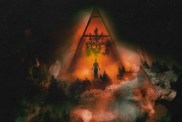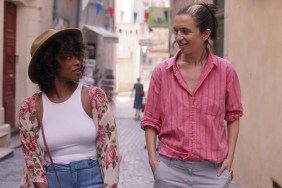
We’ve spent a lot of time philosophizing over zombie movies and whether or not we’re, in fact, the “walking dead.” Be it mindless consumer or empty souls wandering toward a bleak end, the answer is almost always yes. It’s time to move beyond this line of examination, something contemporary undead titles like Deadgirl or Warm Bodies, and now Maggie, have done. Bodies asked if we could come back from the brink of cynical existence. In Maggie, zombiedom is the end, but isn’t a metaphor for some current state of being. Instead, this tender parallel of terminal illness looks at the life of the dying and those that survive them.
Maggie of course stars Arnold Schwarzenegger as Wade, his superstar presence in this quiet drama a curiosity for many. It’s odd, sure, but also both adventurous of the actor and a boon for the film. Arnold wears weathered and subdued well. He’s affecting and credible as a man of the land, the unstoppable action intent of his past films now restrained and focused toward keeping his daughter, Maggie safe.
As Maggie, Abigail Breslin is a standout, her true teendom lending authenticity to the screen. Maggie exists in a world in which a zombie virus is very present and dealt with medically. The process of transforming is much like illness, and thus the emotionally tumultuous process of nearing certain death and saying goodbyesomething many zombie characters don’t get to dois a somber one to watch. The best sequence finds Maggie spend a night with her friends one last time. Director Henry Hobson casts a similar eye for authenticity with them, and so the long night unfolds with a sweet sadness. The final note, Maggie and her best friend embracing, is a tearful one.
There are strangely many opportunities to elicit tears throughout, be it Maggie’s acceptance, Wade’s grief or her stepmother Caroline’s (Joely Richardson) internal clash of great care and great fear. Sometimes these are undercut by overbearing score, heavy piano cues that attempt to do the work for you. The performances are so committed and Hobson and DP Lukas Ettlins visual atmosphere so sensitive and ethereal however, it matters not.
Hobson often follows Maggie‘s ensemble, surveying them in their quietest or most difficult moments. For Wade, that’s both dealing with Maggie’s condition and occasional encounters with the undead. What’s most surprising about the film isn’t that it’s atypical of the genre, or even that it works in being so, but that the threatening zombies themselves are so frightening. One zombie in fact, is likely the creepiest contemporary one we’ve seen, more resembling a walking Fulci corpse than something recognizable as human. The makeup team at Autonomous FX blacks out the zombies’ eyes with such unsettling effect that horror filmmakers would do well to take note the next time they’d like to do so to ghosts, digitally.
Perhaps they’re also so eerie, because they are sparse in this often golden farmland. Hobson’s aesthetic recalls classic Americana, but his grey sky never forgets it’s post-apocalyptic. When the filmmaker isn’t actively following actors, he creates still images that recall the art of Edward Hopper and other American realists. This sidetrack of how a post-apocalypse will likely push us toward a more analog way of life (Wade loves his old truck), and perhaps the comfort of iconic aesthetic, takes on deeper meaning with the casting of Schwarzenegger. The action star’s unmistakable accent reminding us of the immigrant experience, attempting to live out a true life with family and farm and contending with illness and a country in crisis, as well.
Maggie is an earnest, unrepentantly heavy movie. It’s patient and sad in the way life can be, but also something of a joy. Though The Walking Dead has likely converted many, let no one say a zombie film can’t be more than blood and guts.







